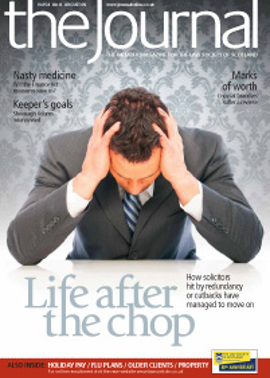Trainee recruitment must be more open

I read with great interest the findings of the recently released Fair Access to the Professions report.
I also read with great interest the press release by the Law Society of Scotland, which stated in response that the “the average solicitor of the future will be female, under 30 and state school educated”. Whilst undertaking the Diploma at the Glasgow Graduate School of Law in session 2007-08 I remember a similar statement at a Society presentation.
How is one supposed to feel when one is male, over 30, albeit state school educated, and still seeking a traineeship after three years of fruitless applications?
Swinging the pendulum from one inequality to another is evidence only of change, not of actual equality or diversity. Presumably the aforementioned statistic indicates that the majority of LLB students are female. Are efforts being planned to encourage more men onto the LLB and hence into the profession?
This numbers game surely misses the point. Any attempt at striving for demonstrable equality or diversity in the profession will only be successful if the member firms are not only aware of the issues but are committed to providing, to coin a phrase, “fair access”, regardless of background, to those seeking entry. However, “fair access” need not, indeed for the profession must not result in trainee applicants being selected for any reason other than merit. Clients deserve and demand no less. There is nothing intrinsically wrong with an apparent excess of, say, one sex over another if access to the profession, i.e. traineeships, are truly being granted on merit. The above report though, strongly suggests otherwise.
I would like to see the Society conduct a review of the recruitment practices of its members. It would also make sense for the Society to provide recruitment “best practice” guidelines that all firms, especially smaller ones without a dedicated HR department, should follow. I invite anyone to browse some of the best practice guidelines already available for free from sources such as ACAS or the CIPD. Then compare these guidelines to any trainee application. It doesn’t always make for welcome viewing.
Arguably the greatest challenge for a prospective trainee is that currently each firm recruits in its own way. Even for two similar firms, their selection criteria (if such even exist in a recognised form) are likely to be very different. I speak from experience.
Adverts for trainees are very often of the “Trainee wanted, apply within” type, with no guidelines within the advert itself, such as job specification and person specification. There is a mishmash of online application forms, downloadable application forms, and CV and covering letter methods. Some firms monitor the backgrounds of their applicants; some firms do not. Some firms advertise only on their websites. Others post adverts to the Diploma office. A very few use the mainstream press or internet job sites.
One practice I would like to see firmly stamped out is this business of speculative applications. If a firm has a trainee vacancy, why not advertise? This method of recruitment all too easily allows a firm, if so minded, to discriminate in any way it pleases by simply telling applicants it doesn’t like the look of, “sorry, no vacancies at present”. The Society could easily put paid to this practice by refusing to register a trainee unless the firm can show it advertised fairly and accessibly to the pool of prospective trainees. Allowing such secretive practices only adds fuel to the “fair access” bonfire currently raging.
In a similar vein, I see no reason why the Society could not produce a generic application form that promotes equal opportunities. This form could be modified by each firm, but only in terms of the competencies and objective criteria required for selection. To further assist in this process the Society could also provide checklists of these competencies and criteria for different types of firm, and the areas of practice the traineeship they offer is likely to specialise in, e.g. mainly commercial, litigation, criminal, conveyancing etc. Any trainee advert could then contain the competencies/criteria required for that role, allowing candidates to tailor their application, or simply not to waste their time applying if they know they do not meet certain criteria. The equal opportunities section could be detachable and copied to the Society.
All of these measures would create a tangible benefit to member firms. They would be following a process approved by their governing body. Instead of sifting through CVs and comparing covering letters, staff involved in recruitment could be scoring application forms against predetermined criteria and creating a genuine merit list of candidates. It would then be a simple matter of deciding how many interviews a firm has time to carry out and selecting the appropriate number of candidates from the top of the list.
Law firms are not exempt from employment tribunal proceedings. Many of the current recruitment methods would have extreme difficulty in standing up to scrutiny from an employment judge. If the profession does not change practice voluntarily from within, it may well be forced to in response to external factors. But change it must.
In this issue
- Planning's big day
- Hair alcohol tests: tackling the root of the problem
- Ask not...
- Trainee recruitment must be more open
- Honest talking
- Out, but not down
- A budget to save the world?
- Uncertain rights
- Copycats: nine lives used up?
- A break from illness?
- On the record
- From the Brussels Office
- Member support: the next level
- Legal practice reinvented
- Beat the pandemic
- Ask Ash
- A vintage problem?
- Final is still final
- Blacklisting blacklists
- A better fitting kilt
- Proper restraint
- Scottish Solicitors' Discipline Tribunal
- Website review
- Book reviews
- Knowledge rules OK?
- Lifting the stones
- Legitimate finding or mortgage fraud?
- Islamic finance: a Scottish lead?
- Environmental Law Centre: taking issues






